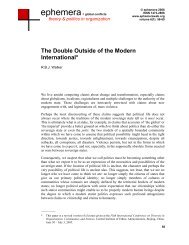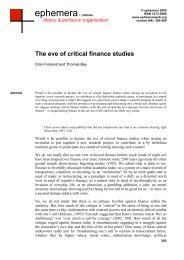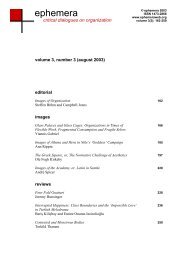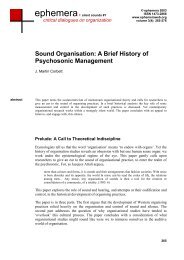Work, play and boredom - Ephemera
Work, play and boredom - Ephemera
Work, play and boredom - Ephemera
Create successful ePaper yourself
Turn your PDF publications into a flip-book with our unique Google optimized e-Paper software.
© 2011 ephemera 11(4): 406-432 Who is Yum-Yum?<br />
articles Niels Åkerstrøm Andersen<br />
Denmark is not the only place where <strong>play</strong> is used as a tool in health campaigns. Engl<strong>and</strong><br />
<strong>and</strong> the USA have similar campaigns. In the USA, there is even a website for the<br />
discussion of different serious health games, ‘Public health games – Serious games <strong>and</strong><br />
Simulations for Public Health <strong>and</strong> related Fields’ (PublicHealthGames.com). Other sites<br />
combine film, information, <strong>and</strong> games for children, e.g. the side ‘Kidshealth’<br />
(KidsHealth.org). Another site is ‘Health Finder’ which is located on the US<br />
Department of Health <strong>and</strong> Human Services website (Healthfinder.gov).<br />
These campaigns bear witness to a discursive shift towards health promotion that has<br />
taken place in the health care system over the past twenty years (Højlund <strong>and</strong> Larsen,<br />
2001; Joyce, 2001; Roy, 2008; Michailakis <strong>and</strong> Schirmer, 2010). In a Danish context,<br />
The Public Health Program marks this shift: ‘The Public Health Program is meant to<br />
ensure political responsibility for an effective prioritization <strong>and</strong> coordination of<br />
preventive efforts across sectors, administrative levels <strong>and</strong> competencies’<br />
(Sundhedsministeriet 1999: 6; Højlund <strong>and</strong> Larsen, 2001).<br />
The public health program identifies the Danish people as one body, which needs to be<br />
healthy, <strong>and</strong>, paradoxically, the construction of this imaginary collective body produces<br />
a new form of individualization according to which the individual is expected to create<br />
<strong>and</strong> administer her or himself in relation to the health system. The campaign organizers,<br />
The National Council for Public Health, define it this way:<br />
Central to health promotion is the notion that the individual needs to be good at mastering his or<br />
her life, <strong>and</strong>, as public authorities, we need to help create the best possible framework. The ability<br />
to master one’s life is not always a private matter. (National Council for Public Health, 2002: 11)<br />
As a whole, the campaign ‘Health through <strong>play</strong>’ can be characterized as a third-order<br />
campaign. The campaign does not address its final target group directly, which are<br />
socially at-risk families, although it is available to this group, since its media includes a<br />
publicly accessible website where children can <strong>play</strong> online games <strong>and</strong> where parents<br />
can find recipes <strong>and</strong> <strong>play</strong> an online game. The campaign primarily addresses public<br />
institutions <strong>and</strong> health professionals who come into contact with at-risk families, <strong>and</strong><br />
the campaign’s message is that these professionals need to campaign to ‘their’ families.<br />
Thus, it is a campaign for campaigns, which is why it includes possibilities <strong>and</strong> different<br />
tools that can be used in the campaigns that address the families directly. As the website<br />
says: ‘”Health through <strong>play</strong>” is a health-pedagogical tool for the health professional<br />
(health visitor, consultation nurse, health consultant, dietician, etc.) working with<br />
families <strong>and</strong> the improvement of food <strong>and</strong> movement habits’ (Ministry of Food,<br />
Agriculture, <strong>and</strong> Fisheries, 2008b). The professions that the campaign addresses do not<br />
answer directly to the campaign. In terms of employment, those who perform services<br />
within the campaign’s sphere of interest may belong to a wide range of different<br />
organizations both regionally <strong>and</strong> in municipalities. The campaign aims to link<br />
functions, roles, <strong>and</strong> employees in a shared health promotion effort across formal<br />
divisions. And the common aim is defined as running a specific campaign in relation to<br />
families. The campaign basically places itself in a situation, therefore, where its diverse<br />
target group is responsible for judging whether it is relevant or imposing. However, the<br />
campaign contains another segment. The goal is not only to make the targeted families<br />
change their behavior. The goal is to convince the families to run internal health<br />
campaigns in relation to themselves! In this sense the campaign share a lot of<br />
409








